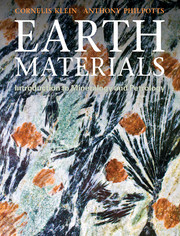Book contents
- Frontmatter
- Contents
- Preface
- Acknowledgments
- Chapter 1 Introduction
- Chapter 2 Materials of the solid Earth
- Chapter 3 How are minerals identified?
- Chapter 4 Fundamentals of crystal structures
- Chapter 5 Introduction to crystallography
- Chapter 6 Minerals and rocks observed under the polarizing optical microscope
- Chapter 7 Igneous rock-forming minerals
- Chapter 8 How do igneous rocks form?
- Chapter 9 Igneous rocks
- Chapter 10 Sedimentary rock-forming minerals and materials
- Chapter 11 Formation, transport, and lithification of sediment
- Chapter 12 Sedimentary rock classification, occurrence, and plate tectonic significance
- Chapter 13 Metamorphic rock-forming minerals
- Chapter 14 Metamorphic rocks
- Chapter 15 Some economic minerals, mainly from veins and pegmatites
- Chapter 16 Some selected Earth materials resources
- Chapter 17 Earth materials and human health
- Glossary
- Minerals and varieties
- Common igneous, sedimentary, and metamorphic rocks
- Index
- References
Chapter 6 - Minerals and rocks observed under the polarizing optical microscope
- Frontmatter
- Contents
- Preface
- Acknowledgments
- Chapter 1 Introduction
- Chapter 2 Materials of the solid Earth
- Chapter 3 How are minerals identified?
- Chapter 4 Fundamentals of crystal structures
- Chapter 5 Introduction to crystallography
- Chapter 6 Minerals and rocks observed under the polarizing optical microscope
- Chapter 7 Igneous rock-forming minerals
- Chapter 8 How do igneous rocks form?
- Chapter 9 Igneous rocks
- Chapter 10 Sedimentary rock-forming minerals and materials
- Chapter 11 Formation, transport, and lithification of sediment
- Chapter 12 Sedimentary rock classification, occurrence, and plate tectonic significance
- Chapter 13 Metamorphic rock-forming minerals
- Chapter 14 Metamorphic rocks
- Chapter 15 Some economic minerals, mainly from veins and pegmatites
- Chapter 16 Some selected Earth materials resources
- Chapter 17 Earth materials and human health
- Glossary
- Minerals and varieties
- Common igneous, sedimentary, and metamorphic rocks
- Index
- References
Summary
Light and the polarizing microscope
In Chapter 3, we saw that the human eye is sensitive to that part of the electromagnetic spectrum known as the visible range. We also saw that the energy transmitted by electromagnetic radiation can be related to its wavelength through a simple equation (Eq. 3.1) involving the Planck constant and the speed of light. The speed of light – 186000 miles per second – is perhaps one of the most familiar physical constants. This is actually the velocity of any electromagnetic radiation in a complete vacuum, and its precise value, in SI units, is 2.9979 × 108 m/s, or ~300000 km/s. When light travels through material, it is slowed down, which results in the path of the light bending or refracting. This has two very important consequences:
It allows us to construct lenses that can be used to make optical instruments such as telescopes, microscopes, or common reading glasses.
When light passes through a mineral, the amount the light is slowed varies from one substance to another. This retardation provides a useful property known as the refractive index, which helps us distinguish and identify minerals.
- Type
- Chapter
- Information
- Earth MaterialsIntroduction to Mineralogy and Petrology, pp. 134 - 155Publisher: Cambridge University PressPrint publication year: 2012



